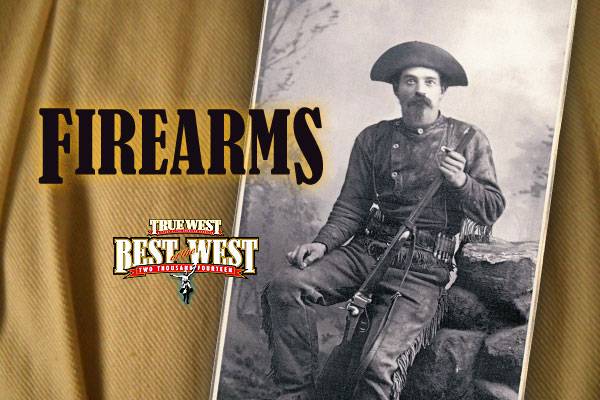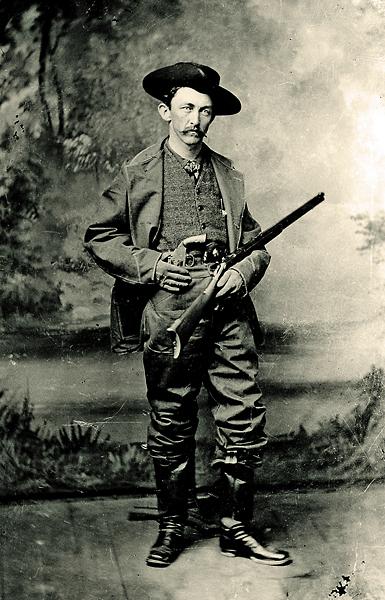 Westward expansion took place during the Industrial Revolution, which was also a time of great evolution in the world of firearms. The development in ignition systems, metallurgy, mechanical design and other arms technology progressed rapidly between 1800 and 1900.
Westward expansion took place during the Industrial Revolution, which was also a time of great evolution in the world of firearms. The development in ignition systems, metallurgy, mechanical design and other arms technology progressed rapidly between 1800 and 1900.***BEST OF THE WEST FIREARMS 2014***
Best Fun With a Gun
Editor’s Choice: Cowboy Fast Draw
Reader’s Choice: Cowboy Action Shooting
•••
Best Gunleather Artisan
Editor’s Choice: John Bianchi Frontier Gunleather
Reader’s Choice: El Paso Saddlery
•••
Best Firearms Engraver
Editor’s Choice: Bill Johns
Reader’s Choice: American Legacy Firearms
•••
Best Cowboy Action Pistol
Editor’s Choice: Colt Single Action Army
Reader’s Choice: Colt Single Action Army
•••
Best Cowboy Action Rifle
Editor’s Choice: Cimarron 1886 Winchester
Reader’s Choice: Uberti Model 1873 Winchester
•••
Best Cowboy Action Shotgun
Editor’s Choice: Cimarron 1883 Double Barrel Shotgun .410
Reader’s Choice: Cimarron 1887 Hammered Coach Gun
Photo Gallery
This dapper gent packs a Model No. 3 American, Smith & Wesson’s first heavy caliber revolver, made from 1870-72, and a pocket pistol as backups to his 1873 Winchester lever-action rifle. Designed as an improvement of the American model, the Schofield was outlaw Jesse James’s favorite gun. Buffalo Bill Cody relied on it during his early pre-Wild West show days, and it was also carried by El Paso lawman Dallas Stoudenmire.
– Courtesy Herb Peck Jr. Collection –
Among the number of firearms Buffalo Bill Cody used throughout his colorful career, the one he held the highest in esteem was the 1866 Springfield .50-70 Allin conversion single-shot rifle he employed in buffalo hunts during his early scouting days (he holds it in his lap). Although others knew the rifle as the “needle gun,” due to its long firing pin, Cody called his “Lucretia Borgia.” Like the famous Renaissance femme fatale, she was “beautiful, but deadly.”
– Courtesy Buffalo Bill center of the west, Cody, Wyoming, P.6.906 –
In this rare outdoor view of the 10th Cavalry Buffalo Soldiers working with Apache scouts during the Indian Wars in Arizona circa 1885, the background shows an intriguing scene: one Buffalo Soldier blows his bugle, the next points his pistol skyward, while the last aims his weapon directly at the photographer.
– Courtesy Steve Turner –
The practice of embellishing firearms with brass tacks is age old, found on European wheellocks and North African miquelets. On the North American frontier, whites traded tacks and studs to the Indians, who used them to decorate their gear. This Canadian Blackfoot not only has tacked up his 1873 Winchester carbine, but also his knife scabbard, riding quirt, waist belt and his pony’s headstall. His breastplate is even made up of brass serpentine side locks from antique trade guns.
– True West Archives –
Given the duck decoys scattered on the floor, Arizona’s Cochise County Sheriff John H. Slaughter probably used the 1887 Winchester lever-action shotgun he’s holding for hunting. We don’t know if he used it for his law enforcement career, but the shotgun was certainly powerful enough to help him get his man! The sheriff is also packing a pearl-handled 1873 Colt Peacemaker.
– True West Archives –
While trailing cattle to Kansas in 1871, the deadly John Wesley Hardin holed up with his Winchester rifle and shot it out against a group of men pursuing him. This unknown cowboy from Caldwell is armed for bear himself, with his 1873 Winchester, Colt Peacemaker and a Bowie knife, in this photo likely taken during the boom days of the Kansas cattle towns.
– Courtesy Robert G. McCubbin Collection –
Two German-born brothers, Frank W. and George Freund, followed the track of the Union Pacific Railroad westward, including to Laramie, Wyoming Territory, where, in the photo at right, the man on the sand mound holds a double-key percussion muzzleloader, while the man to his right holds an 1866 Winchester. By 1870, with the Union Pacific built, the brothers had opened shop in Denver, Colorado, and eventually went on to secure patents for Sharps, Remington, Colt and other big gun manufacturers.
– Courtesy Union Pacific railroad Museum –
– Courtesy Herb Peck Jr. Collection –
With the “most dangerous outlaw in Indian Territory,” Ned Christie, lying dead on a board, the U.S. deputy marshals pose in 1892 with their 1873 and 1886 Winchester lever-action rifles, along with one trapdoor Springfield .45-70 single-shot rifle. The Cherokee renegade, accused of murdering a U.S. marshal, held his .44-40, 1873 Winchester for the last time.
– True West Archives –
To take advantage of the popularity of the Colt’s 1873 Single Action Army, Remington made a Peacemaker clone in its 1875 model. At the onset, sales were brisk, but Remington never secured the military contract Colt had with its Peacemaker. In 1883, the U.S. Interior Department did purchase more than 600 revolvers to issue to Indian police agencies on the frontier, like these Nez Perce police in Salmon, Idaho, but the 1875 Remington never seriously rivaled the Colt and production ceased in 1889.
– Courtesy Phil Spangenberger –
The abundance of 1892 and 1894 Winchester rifles in the array of weapons and ammunition next to this Revolutionist vaquero explains the popularity of the Mexican Revolution folk song, “Carabina Treinta Treinta,” about the .30-30 carbine.
– Courtesy Garry James Collection —
Dubbed by Plains Indians as the “shoot today, kill tomorrow” gun, the 1874 Sharps wielded by this frontiersman in Leadville, Colorado, was primarily a buffalo hunting rifle, but was occasionally used in battle, like at the Battle of Adobe Walls in 1874, when Billy Dixon made his famous long-distance shot with a borrowed “Big Fifty.”
– Courtesy Robert G. McCubbin Collection –
The presence of firearms can help photo collectors date their images, as in this example of a gentleman with his Model 1860 Spencer seven-shot repeater. The Western gent’s clothing (bib front shirt, neckerchief, trousers tucked into high top boots and an upturned, broad-brimmed hat) and the photographic studio marking of Durango, Colorado, on the carte de visite suggest this photo dates to around the town’s founding, in 1881. He probably had bought the Spencer cheaply, as Civil War surplus.
– Courtesy Phil Spangenberger –



















